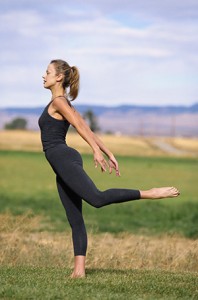
The word yoga derives from the Sanskrit yuj, meaning to yoke or join together. It is science and art, discipline and play, affecting the whole person, not just the physical body.
by Kathleen Bryant —
Like its symbol, the lotus, the practice of yoga unfolds a petal at a time. Asana, the physical posture of yoga, comprises only one of eight limbs or aspects of yoga. The others include ethical behavior, personal disciplines, breath and energy work, and progressive levels of concentration and meditation.
Many Westerners are drawn first to yoga’s myriad physical benefits. Asana moves the spine in all directions; massages the organs, glands and lymph vessels; improves bone health, lung efficiency and mental concentration; balances the nervous system and promotes relaxation.
But yoga is more than exercise. The word yoga derives from the Sanskrit yuj, meaning to yoke or join together. It is science and art, discipline and play, affecting the whole person, not just the physical body. It is a way to strengthen the spirit and stretch beyond the mind. Ultimately, it helps us remember the unity underlying all creation.
Yoga’s roots lie in the early shamanistic traditions of India, later influencing and influenced by Hinduism, Jainism and Buddhism. As a shamanic practice, yoga postures celebrate the earth and many forms of nature.
If you balance yourself next to an ancient juniper — whose roots have penetrated rock and whose branches have withstood lightning and withering heat — you begin to truly understand the essence of the tree pose. Feet root into stone as leg muscles engage, creating stability and a sense of groundedness, while the upper body rises toward the sky, mimicking the dynamic polarity between earth and heaven.
Lie belly-down on sun-warmed sandstone in the cobra pose and you will stimulate the body’s fire center, the area of the body where digestion and assimilation take place. This is the place where we take in not only nourishment but also experiences, and it’s here at the solar plexus where we process both food and feelings.
Yoga and nature weave together like the silvery gray and maroon of a manzanita branch. Yoga connects us to all of life, using the language of the physical as a metaphor for qualities that go deeper than skin: flexibility, strength, balance, grace, extension and openness, to name a few.
As the practice of yoga unfolds, so do the layers of self. The body changes. The knots — tension caused by trauma or repressed memories — gradually unravel. Priorities shift. Tolerance and equanimity become easier; so does living in the present moment. The heart expands to hold all beings — including oneself — in compassion and kindness.
Eventually, we stop “doing” yoga and start living it. Then we discover that this microcosm we think of as self has been part of something far greater all along. This, too, is yoga.
Kathleen Bryant teaches postnatal and restorative yoga and assists with teacher training at 7 Centers Yoga Arts in Sedona, Ariz. 928-203-4400 or www.7centers.com.
Reprinted from AzNetNews, Volume 24, Number 4, August/September 2005.





October 1, 2013
Exercise, Health, Meditation, Spiritual, Philosophical and Metaphysical, Yoga